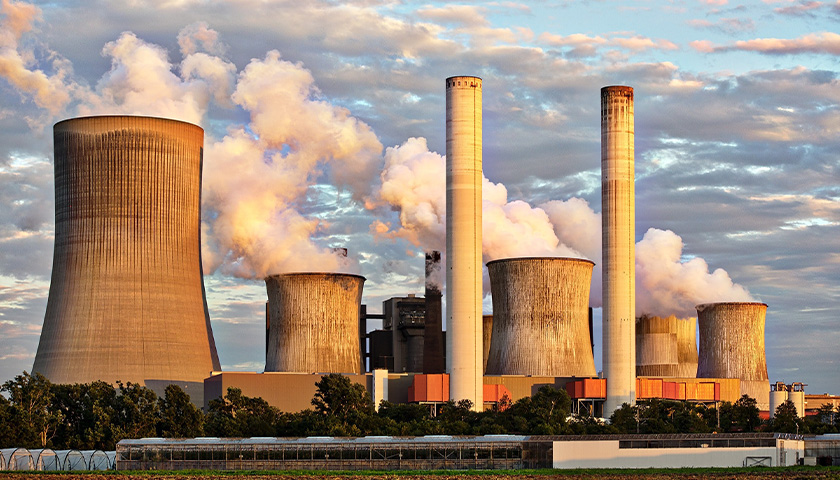by John Solomon
With the price of everything from gasoline to food soaring in America, nobody is surprised by inflated price tags these days. But even by Washington standards, an action taken earlier this month by the Environmental Protection Agency is creating sticker shock: a nearly fourfold increase in the government calculation of damages from carbon emissions.
The so-called Social Cost of Carbon was first set in 2009 under then-President Barack Obama. Under Democrats it has been set for most of the last decade at $51 per metric ton. But in a rulemaking notice in mid-November, EPA said it had devised a new calculation that raises that damage estimate to $190 per metric ton by 2022 standards and as much as $410 by the year 2080.
The figure isn’t just hypothetical. If enacted, it could affect everything from the cost of methane regulations and tailpipe emissions to the “climate reparations” that President Joe Biden has committed the United States to paying to poor countries in the future.
The new estimate has sent shockwaves through the energy industry and raised the stakes for ongoing litigation being brought by Republican attorneys general in states like Louisiana that are challenging the Biden administration Social Cost of Carbon rulemaking as unconstitutional.
One of the key litigators told Just the News that if the Social Coat of Carbon rule stands it one day will affect the prices consumers pay on products from the dinner table to the heating furnace.
“If you think about the fact that they would impose this damage factor, let’s say on farmers, because it applies to fertilizer,” Louisiana Solicitor General Liz Muiller said in an interview on the John Solomon Reports podcast. “Fertilizer emits nitrous oxide. So fertilizer is a big contributor. If every family farmer now is going to have to pay more to obtain fertilizer to fertilize crops that feed us, well, what’s that going to do to the price of food?
“If you’re industrial, if you use plastic products in anything that’s touched by petroleum, it’s going to increase the cost of producing those goods. And that’s all going to be passed on to the consumer.”
The next arguments in Louisiana’s case occur Dec. 7 in the 5th U.S. Circuit Court of Appeals. Muiller said the government has tried to argue the Social Cost of Carbon figure isn’t being used yet in official government actions but she and other states have evidence it is already being used in the regulatory process.
The Social Cost of Carbon is a concept first embraced by the Obama administration in 2009, which set up an interagency working group that calculated the cost to be $51 per metric ton of greenhouse gas emissions. The Trump administration reduced that estimate to $1 to $7 per metric ton, and then Biden’s team returned to the $51 figure in 2021.
While loathed by the energy industry and energy-producing states and mostly unknown to most Americans, the Social Cost of Carbon effort is championed by environmental groups. The Sierra Club, for instance, last year published an article boasting the rule was the “most important climate policy lever you’ve never heard about.”
“Right-wing free-market fundamentalists hate it,” the environmental group wrote. “Progressive policy wonks love it. Some climate advocates say that without it the United States has little chance of getting a grip on our greenhouse gas problem.”
The EPA is the first agency to publicly propose a massive adjustment upwards. It buried the new figure in a 137-page draft supplemental report that was attached this month to new methane emissions rules for the natural gas industry, catching many by surprise.
Using a statistical methodology it said it got from the National Academies of Science, EPA created three estimates of the Social Cost of Carbon at $120, $190 or $340 per metric ton. The calculations were based on “discount rates” of 2.5%, 2.0% and 1.5% that reflected different emissions scenarios. The EPA settled on the middle case scenario as the best estimate right now, setting the price at $190.
You can read that report here.
The implementation through regulations will eventually create a pass-through cost for consumers, experts say.
Tim Stewart, the president of the U.S. Oil and Gas Association, told Just the News on Wednesday that his industry has already calculated the future increases Americans will pay on products based on the new estimates the Biden administration put forth this month.
At the $340 price point, for instance, there would be a $2.99 tax/penalty per gallon of gasoline and $3.47 per gallon of diesel, Stewart said.
“In other words, EPA is saying you’re causing $3 in damages for every gallon of gasoline you use,” he explained.
Stewart said the massive increases in the estimates show the Social Cost of Carbon rule is “detached from reality” and EPA’s provision of three very different scenarios illustrates how “malleable the calculations are to help them balance out the high cost of their own rulemaking.”
Muiller agreed, saying Louisiana believes the Social Cost of Carbon figures are just a “made up number” and the latest in a line of Democrat-backed regulatory actions designed to price fossil fuels out of the marketplace.
“It originates from a motivation to move away from fossil fuels,” she said. “And so once you start from that fundamental motivation, there are a whole lot of groups and organizations” that “all collectively have the same objective, and they start looking for ways and tools to accomplish that objective, and this is one of the tools that they’ve come up with that would help them accomplish that.”
– – –
John Solomon is an award-winning investigative journalist, author and digital media entrepreneur who serves as Chief Executive Officer and Editor in Chief of Just the News.
Photo “Power Plant” by Pixabay.





